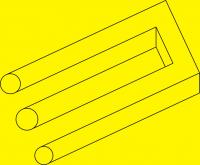Sometimes moves in the wrong direction
- Rick G
-

- Offline
- Junior Member
-

- Posts: 27
- Thank you received: 155
Have you checked the voltage of the port, it seems that some only output around 3.5 volts instead of 5 volts.
Some break out boards are fine with 3.5 volts others may have problems.
You need to isolate the problem computer / parallel port / cable / driver
Can you try another parallel port card?
Another cable?
How about trying another computer to isolate where the problem is.
Rick G
Please Log in or Create an account to join the conversation.
- cncbasher
- Offline
- Moderator
-

- Posts: 1744
- Thank you received: 288
Please Log in or Create an account to join the conversation.
- andypugh
-

- Offline
- Moderator
-

- Posts: 23541
- Thank you received: 5013
I mean from the computer parallel port side. Unfortunately you are correct that an ammeter has to be inserted into the circuit to work. You might have to make a short parallel port breakout cable (male and female connectors and a set of discrete wires) to get to the bottom of this.Do you mean the parallel port issue from the computer side or the driver side? Driver side? How do I measure the current of the signal without cutting the wire and running an ammeter in series?
As RickG says, it might be a marginal-voltage p-port which is slightly overheating the direction pin (because that is the one that stays on permanently)
The driver will generally have an opto-isolator on the input, and the current through this is normally set by a resistor inside the driver, and will normally be set to about 10mA.Do you mean the signal output from the parallel port from the computer is often 3-5mA and the parallel port from the driver can often accept 15mA? This is a closed black box sherline driver that I cant open without voiding warrenty so I dont know whats inside.
The Sherline docs say that their box needs at least 2V to register a "high" and less than 0.5V to register a "low", so it should work with a 3.3V parallel port too, if that is what you have.
The breakout connector that I mentioned above would be useful for checking if your direction signal tends to "sag" over time, as that would indicate that your p-port is low on current capability. There is a solution to this using pull-up resistors from the parallel port (which also needs that you need the breakout adaptor)
However, before getting too far into the hardware we need to make properly sure that EMC2 isn't to blame, and that is where checking what EMC2 thinks it is sending to the direction pin with Halscope comes in. Alternatively you can use this little utility here (instead of EMC2) and you can try driving the motors in single steps in each direction manually toggling the direction lines:
wiki.linuxcnc.org/emcinfo.pl?Parallel_Port_Tester
Please Log in or Create an account to join the conversation.
- E_M_C_user
- Offline
- New Member
-

- Posts: 8
- Thank you received: 0
I tried another cable and it makes no difference. In terms of another parallel port, I was looking into that but I only have the one computer around the house with a parallel port these days. I could order in a PCI card parallel port from newegg or something but that will take a day or two so i can report back when after I buy one.
In terms of stepper wiring, I never touched it, and they come default from the factory. There are also directional connectors so you cant be plugged wrong unless there are manufacturing errors. However, since the motor does seem to work properly the first few minutes of turning the driver on, I dont think it is wrong wiring of the motors. THeres some issue that is leading to error over time, as if there is error/problem buildup, such as increase in temperature or charge buildup or something. I dont know if its a thermal issue causing charge leakage of the transistors or something? temperature affecting the resistance of the resistors and throwing the circuit off? I dont know Im brainstorming.
I cant open the driver up, but if I could another way to estimate current may be to measure the unloaded resistance of a wire or resistor there in series with the connector and then measuring its voltage during load and calculating current? But I cant do this anyway since I cant open it up.
The thing is, the problem goes away when I switch the extra A axis with the problematic axis cable. Speaking without measuring the actual signal over time and based on observation, the directional changing capability definately does get worse over time, although that speaks nothing about the computer output signal itself. However, my other test whereby I left the computer and everything on but only switched off the driver to cool down, and after cooling down the driver only, the problem goes away for the first few minutes. So I am still suspecting it is the driver.
Im looking into how to use halscope now (never used it before). But I can already speak from my trials that EMC2 thinks its going in the right direction. I say zero my stage. I then manually toggle left a bit, and then back to zero. Then I toggle right and back to zero. I repeat this loop. However looking at the stage, it goes one direction only. EMC2 definately thinks its been just doing left step, zero, right step, zero. So the DRO is always zero when I finish, but the stage is only moving 1 direction.
In this site: cockrum.net/cnc.html, the author describes a problem essentially similar to mine, where there is drifting of the 0,0 position. In his case, it is a bad resistor and circuit causing some timing issues. I am not sure what my problem is, but I get that same problem, the stage drifts over time.
Please Log in or Create an account to join the conversation.
- kostas
-

- Offline
- Premium Member
-

- Posts: 111
- Thank you received: 6
You might also consider using a freeze spray (or a compressed air spray upside down) to cool the components one by one and see if you can find a problematic one.
Please Log in or Create an account to join the conversation.
- cncbasher
- Offline
- Moderator
-

- Posts: 1744
- Thank you received: 288
i.e pc side .
it may well be that your inbuilt parrell port is marginal .
or the current limiting of the drive is wrong , and therfore overheating . i am presuming nothing has changed from the origional supplied setup ,
sounds as if your on the right track , i'd try a pci card first .
Please Log in or Create an account to join the conversation.
